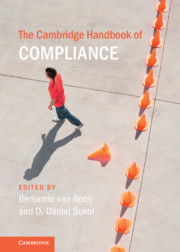Book contents
- The Cambridge Handbook of Compliance
- The Cambridge Handbook of Compliance
- Copyright page
- Contents
- Figures
- Tables
- Contributors
- 1 Introduction: Compliance as the Interaction between Rules and Behavior
- Part I Compliance Concepts and Approaches
- Part II Deterrence and Incapacitation
- Part III Incentives
- 22 Does Tort Deter? Inconclusive Empirical Evidence about the Effect of Liability in Preventing Harmful Behaviour
- 23 Crowding-Out Effects of Laws, Policies and Incentives on Compliant Behaviour
- 24 Financial Incentives for Whistleblowers: A Short Survey
- 25 Designing Corporate Leniency Programs
- 26 Incentive Contracts
- Part IV Legitimacy and Social Norms
- Part V Capacity and Opportunity
- Part VI Compliance and Cognition
- Part VII Management and Organizational Processes
- Part VIII Measuring and Evaluating Compliance
- Part IX Analysis of Particular Fields
- References
23 - Crowding-Out Effects of Laws, Policies and Incentives on Compliant Behaviour
from Part III - Incentives
Published online by Cambridge University Press: 07 May 2021
- The Cambridge Handbook of Compliance
- The Cambridge Handbook of Compliance
- Copyright page
- Contents
- Figures
- Tables
- Contributors
- 1 Introduction: Compliance as the Interaction between Rules and Behavior
- Part I Compliance Concepts and Approaches
- Part II Deterrence and Incapacitation
- Part III Incentives
- 22 Does Tort Deter? Inconclusive Empirical Evidence about the Effect of Liability in Preventing Harmful Behaviour
- 23 Crowding-Out Effects of Laws, Policies and Incentives on Compliant Behaviour
- 24 Financial Incentives for Whistleblowers: A Short Survey
- 25 Designing Corporate Leniency Programs
- 26 Incentive Contracts
- Part IV Legitimacy and Social Norms
- Part V Capacity and Opportunity
- Part VI Compliance and Cognition
- Part VII Management and Organizational Processes
- Part VIII Measuring and Evaluating Compliance
- Part IX Analysis of Particular Fields
- References
Summary
Abstract: Laws, policies, and incentives provide people with extrinsic reasons to engage in desired behaviours. But by doing so, they may attenuate or displace people’s intrinsic reasons for complying. In this chapter, I review theorising and empirical evidence on such crowding-out effects. I outline perspectives from psychology and economics on how laws, policies, and incentives may undermine people’s intrinsic motivation. Moreover, I describe how such insights have been applied to explain why laws, policies, and incentives may fail to increase compliance – or may even undermine it. The chapter then reviews the empirical evidence on these processes in environmental, organisational, and other legal settings. Although it is plausible that laws, policies, and incentives affect intrinsic motivation to comply, I conclude that empirical evidence of these processes is still modest. I end the chapter by outlining some important directions for future research and some (tentative) recommendations for policy.
- Type
- Chapter
- Information
- The Cambridge Handbook of Compliance , pp. 326 - 340Publisher: Cambridge University PressPrint publication year: 2021
References
- 5
- Cited by

